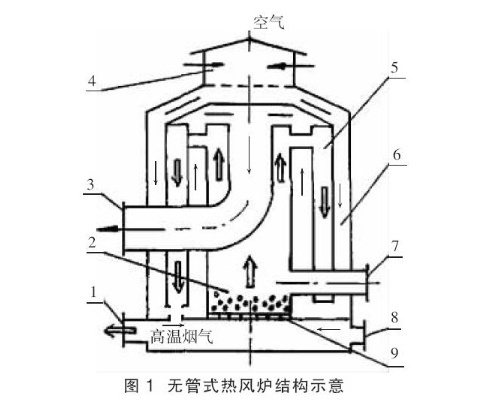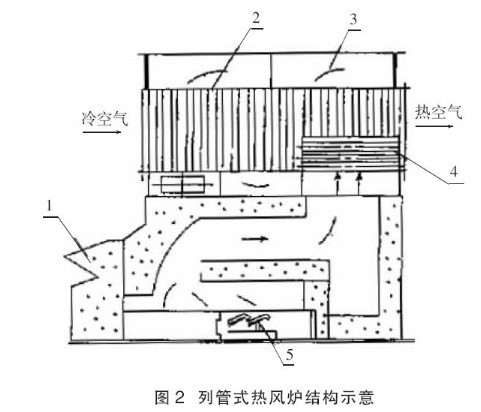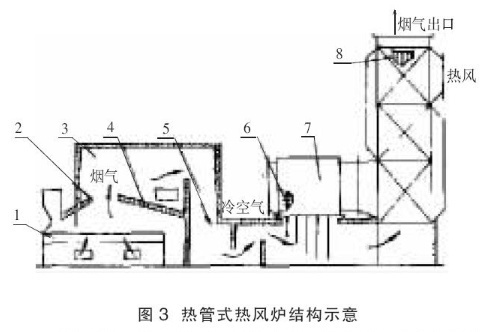Widely applied in agricultural production, agricultural products and food processing, metallurgy, building materials and other industries, hot-air stove is not only the main auxiliary equipment for air drying, spray drying, fluidized drying, tower drying, tunnel drying and rotary drying, etc., but also the main equipment for heating greenhouses and livestock farms. The hot air generated by the hot-air stove can be used either to dry the materials through heating and evaporating, or to heat greenhouses and farms for the growth of animals and plants. In addition, hot-air stove, as a heat exchange medium, is also extensively applied for heating in various construction industries, household heating supply, etc.
At present, tubeless hot air stoves, tubular hot air stoves and heat pipe hot air stoves in large, medium and small models are the most widely used types with many manufacturers in China.
1. The structure and characteristics of tubeless hot-air stoves.
Most of the hot air stoves used for indirect heating of coal (gas) are tubeless (sleeve type) and tubular type. Tubeless hot-air stoves are all-steel welded without heat exchange tube, in which the heat exchanger and the furnace are designed as one piece and rolled from steel plates, so they are called as tubeless hot-air stoves. Tubeless hot-air stoves are mainly composed of combustion chamber, grate, flue gas box, air box, coal feeding hole, ash hole, hot air outlet, flue gas outlet, and cold air inlet, as shown in Figure 1.

According to the fuel used, tubeless hot-air stoves can be divided into coal-fired and gas-fired, where the former is featured by abundant fuel sources and low fuel costs, but complex structure, large size, poor sanitary conditions and high pollution; the latter are simple in structure, relatively smaller, with good sanitary conditions and basically no pollution, but high fuel cost.
In tubeless hot-air stoves, the combustion chamber and heat exchanger are integrated, and the flue gas is used as a heat carrier to heat the air through the heat transfer of heat exchange wall such as the sleeve or the multi-steering spiral plate. After heat exchange, part of the flue gas is recycled and used, and the rest is discharged from the chimney through the flue. Characterized by small size, low heat loss, low cost, simple structure, strong adaptability, convenient installation, long service life, stable thermal performance and excellent thermal efficiency, this type of hot-air stoves are suitable for occasions where the dried materials shall not be polluted, such as drying medicine, tea, starch and fur, as well as household heating, and the temperature can reach 140~180℃.However, there are disadvantages such as easy burn-through of the heat exchanger top plate in direct contact with the furnace and difficult to repair. However, there are disadvantages such as easy burn-through of the heat exchanger top plate in direct contact with the furnace and difficult to repair.
2. The structure and characteristics of the tubular hot-air stoves.
Tubular hot-air stoves indicate that the heat exchanger consists of a plurality of heat exchange tubes arranged in a certain order, whose main structures are furnace, tubular heat exchanger, flue, chimney, etc. (Figure 2).

Composed of tube bundles, the heat exchanger in tubular hot-air stoves is to transfer the heat of flue gas to the air side with a relatively low temperature through the tube wall, so as to realize cross ventilation. Meanwhile, the flue gas and air flow outside and inside the tube respectively to achieve heat exchange between flue gas and air. In order to meet the requirements of various specific working conditions and environments, the tubular hot-air stoves practically can be divided into vertical and horizontal types according to the placements. The vertical type refers to the integrated tubular hot-air stoves with heat exchanger placed directly above the furnace, which is mostly used for small and medium-sized hot-air stoves in small thermal power. Horizontal type means that the heat exchanger and the furnace are placed side by side and connected by the flue, which is mostly used for large and medium-sized hot air stoves in large thermal power. Tubular hot-air stove is a relatively common structural form in the indirect heating hot-air stove, in which the flue gas exchanges heat with the pure air through the tubes. Due to the uneven heat load, the heat exchange tubes in direct contact to the flame need to be replaced frequently as they are in a service life as short as 500h, easy to scale, not easy to clean, and in low thermal efficiency.
Tubular hot-air stoves are advantaged with low cost, simple structure, strong adaptability, convenient installation and maintenance, etc., but hard to replace because of large size. In this type of hot-air stove, flue gas is used as a heat carrier to heat the air through the heat transfer of the metal wall. Tubular hot-air stoves are mainly suitable for drying various foods, corn, wheat and other grain crops since the output is clean hot air.
3. Structure and characteristics of heat pipe hot-air stoves.
Composed of furnace and heat pipe heat exchanger (Figure 3)

heat pipe hot-air stoves is heat exchange equipment that supplies the heat generated by the hot air to the heat pipe heat exchanger, and then directly to the heated device. As the core components, heat pipe and the heat pipe heat exchanger are decisive to the quality of heat pipe hot-air stoves. Heat pipe is a heat transfer element with extremely high thermal conductivity, which transfers heat through the evaporation and condensation of working medium in a fully enclosed vacuum tube. With extremely high thermal conductivity, good isothermal performance, free change of heat transfer area on both sides, heat pipe hot-air stoves can achieve long-distance heat transfer and controllable temperature. Consisting of tube shell, capillary wick and working medium, the heat generated is transferred to the heat pipe heat exchanger using the heat transfer element of high temperature heat pipe, and then directly supplied to the heated equipment.
In this type of hot-air stoves, the high temperature zone and low temperature zone can adopt heat pipes of different structures, which are easy to disassemble and install, can solve the problem of thermal expansion. Besides, the flue gas exchanges heat outside the tube, so it is easy to clean the dust deposits. Due to the principle of air-air heat exchange, finned tubes are used to greatly increase the heat transfer power of a single tube and create a compact overall structure. Heat pipe heat exchange technology is widely used in solar energy utilization to convert low heat flux density into high heat flux output. In addition, it is widely used in places where constant temperature is required, such as in the laboratory, and is also applied in the drying of agricultural and sideline products, medicinal materials, wood, etc.
4. Summary.
The general heat exchanger only involves the heat exchange of the two fluids, cold and hot rather than the combustion of fuel or the corresponding conversion from chemical energy of fuel to thermal energy. Different from the general heat exchanger, hot-air stoves must include two processes: the combustion of fuel and the heat exchange between combustion products and the air. So a hot-air stove is more like a normal boiler in some ways, but it provides hot air instead of hot water or steam. As a heat exchange medium, hot air is not only used for drying various materials, but also for heating various rooms, such as greenhouses, households, etc.
